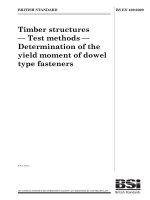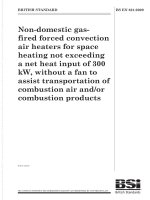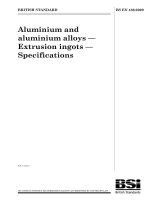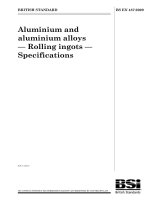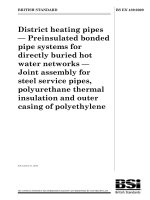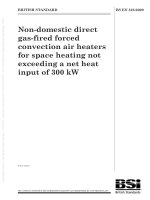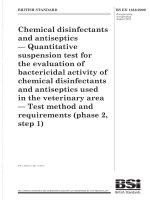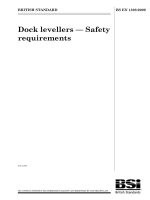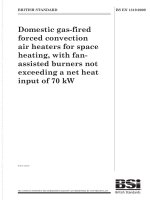Bsi bs en 62223 2009
Bạn đang xem bản rút gọn của tài liệu. Xem và tải ngay bản đầy đủ của tài liệu tại đây (1.15 MB, 22 trang )
Licensed Copy: athen reading, Reading University Library, 24/01/2010 05:00, Uncontrolled Copy, (c) BSI
BS EN 62223:2009
BSI Standards Publication
Insulators — Glossary of terms
and definitions
NO COPYING WITHOUT BSI PERMISSION EXCEPT AS PERMITTED BY COPYRIGHT LAW
raising standards worldwide™
BRITISH STANDARD
Licensed Copy: athen reading, Reading University Library, 24/01/2010 05:00, Uncontrolled Copy, (c) BSI
BS EN 62223:2009
National foreword
This British Standard is the UK implementation of EN 62223:2009. It is
identical to IEC 62223:2009.
The UK participation in its preparation was entrusted to Technical Committee
PEL/36, Insulators for power systems.
A list of organizations represented on this committee can be obtained on
request to its secretary.
This publication does not purport to include all the necessary provisions of a
contract. Users are responsible for its correct application.
© BSI 2010
ISBN 978 0 580 54656 3
ICS 01.040.29; 29.080.10
Compliance with a British Standard cannot confer immunity from
legal obligations.
This British Standard was published under the authority of the Standards
Policy and Strategy Committee on 31 January 2010
Amendments issued since publication
Amd. No.
Date
标准分享网 www.bzfxw.com 免费下载
Text affected
Licensed Copy: athen reading, Reading University Library, 24/01/2010 05:00, Uncontrolled Copy, (c) BSI
BS EN 62223:2009
EUROPEAN STANDARD
EN 62223
NORME EUROPÉENNE
EUROPÄISCHE NORM
November 2009
ICS 29.080.10
English version
Insulators Glossary of terms and definitions
(IEC 62223:2009)
Isolateurs Lexique de termes et définitions
(CEI 62223:2009)
Isolatoren – Glossar
(IEC 62223:2009)
This European Standard was approved by CENELEC on 2009-09-01. CENELEC members are bound to comply
with the CEN/CENELEC Internal Regulations which stipulate the conditions for giving this European Standard
the status of a national standard without any alteration.
www.bzfxw.com
Up-to-date lists and bibliographical references concerning such national standards may be obtained on
application to the Central Secretariat or to any CENELEC member.
This European Standard exists in three official versions (English, French, German). A version in any other
language made by translation under the responsibility of a CENELEC member into its own language and notified
to the Central Secretariat has the same status as the official versions.
CENELEC members are the national electrotechnical committees of Austria, Belgium, Bulgaria, Cyprus, the
Czech Republic, Denmark, Estonia, Finland, France, Germany, Greece, Hungary, Iceland, Ireland, Italy, Latvia,
Lithuania, Luxembourg, Malta, the Netherlands, Norway, Poland, Portugal, Romania, Slovakia, Slovenia, Spain,
Sweden, Switzerland and the United Kingdom.
CENELEC
European Committee for Electrotechnical Standardization
Comité Européen de Normalisation Electrotechnique
Europäisches Komitee für Elektrotechnische Normung
Central Secretariat: Avenue Marnix 17, B - 1000 Brussels
© 2009 CENELEC -
All rights of exploitation in any form and by any means reserved worldwide for CENELEC members.
Ref. No. EN 62223:2009 E
Licensed Copy: athen reading, Reading University Library, 24/01/2010 05:00, Uncontrolled Copy, (c) BSI
BS EN 62223:2009
EN 62223:2009
–2–
Foreword
The text of document 36/287/FDIS, future edition 1 of IEC 62223, prepared by IEC TC 36, Insulators, was
submitted to the IEC-CENELEC parallel vote and was approved by CENELEC as EN 62223 on
2009-09-01.
The following dates were fixed:
– latest date by which the EN has to be implemented
at national level by publication of an identical
national standard or by endorsement
(dop)
2010-06-01
– latest date by which the national standards conflicting
with the EN have to be withdrawn
(dow)
2012-09-01
Annex ZA has been added by CENELEC.
__________
Endorsement notice
The text of the International Standard IEC 62223:2009 was approved by CENELEC as a European
Standard without any modification.
In the official version, for Bibliography, the following note has to be added for the standard indicated:
IEC 60507
NOTE Harmonized as EN 60507:1993 (not modified).
www.bzfxw.com
__________
标准分享网 www.bzfxw.com 免费下载
Licensed Copy: athen reading, Reading University Library, 24/01/2010 05:00, Uncontrolled Copy, (c) BSI
BS EN 62223:2009
–3–
EN 62223:2009
Annex ZA
(normative)
Normative references to international publications
with their corresponding European publications
The following referenced documents are indispensable for the application of this document. For dated
references, only the edition cited applies. For undated references, the latest edition of the referenced
document (including any amendments) applies.
NOTE When an international publication has been modified by common modifications, indicated by (mod), the relevant EN/HD
applies.
Year
Publication
IEC 60050-471
-
1)
Title
EN/HD
Year
International Electrotechnical Vocabulary Part 471: Insulators
-
-
www.bzfxw.com
1)
Undated reference.
Licensed Copy: athen reading, Reading University Library, 24/01/2010 05:00, Uncontrolled Copy, (c) BSI
BS EN 62223:2009
–2–
62223 © IEC:2009
CONTENTS
1
Scope ...............................................................................................................................5
2
Normative references .......................................................................................................5
3
Terms and definitions .......................................................................................................5
Bibliography.......................................................................................................................... 18
www.bzfxw.com
标准分享网 www.bzfxw.com 免费下载
Licensed Copy: athen reading, Reading University Library, 24/01/2010 05:00, Uncontrolled Copy, (c) BSI
BS EN 62223:2009
62223 © IEC:2009
–5–
INSULATORS –
GLOSSARY OF TERMS AND DEFINITIONS
1
Scope
This International Standard specifies terms defined in standards that fall under the scope of
technical committee TC 36: Insulators. It covers terms that can be found in IEC 60050-471 as
well as terms not appropriate for inclusion in IEC 60050-471 but used widely in the standards
of IEC TC 36.
IEC 60050-471 is not intended to cover all the terms used in the various IEC standards but
provides rather a general purpose vocabulary giving the basic terms and reference terms to
be used by all technical committees. This glossary is intended to harmonize terms not listed in
IEC 60050-471 but used in the publications of committee TC 36.
2
Normative references
The following referenced documents are indispensable for the application of this document.
For dated references, only the edition cited applies. For undated references, the latest edition
of the referenced document (including any amendments) applies.
IEC 60050-471, International Electrotechnical Vocabulary – Part 471: Insulators
3
www.bzfxw.com
Terms and definitions
For the purposes of this document, the following terms and definitions apply.
3.1
angular deviation of fixing holes
rotational displacement, expressed as an angle, between corresponding fixing holes in the
end fittings at the top and bottom of a hollow insulator or a post insulator
3.2
annealed glass
glass which has been treated to eliminate internal stresses
[IEV 471-01-25]
3.3
antipollution-type insulator
insulator which has the external profile designed for use in polluted areas
[IEV 471-01-23]
3.4
arcing distance
shortest distance in air external to the insulator between the metallic parts which normally
have the operating voltage between them
[IEV 471-01-01]
Licensed Copy: athen reading, Reading University Library, 24/01/2010 05:00, Uncontrolled Copy, (c) BSI
BS EN 62223:2009
–6–
62223 © IEC:2009
3.5
ball and socket coupling
coupling consisting of a ball, a socket and a locking device, and providing flexibility
[IEV 471-03-11]
3.6
bushing
device that enables one or several conductors to pass through a partition such as a wall or a
tank, and insulate the conductors from it
NOTE 1 The means of attachment (flange or fixing device) to the partition forms part of the bushing. The
conductor may form an integral part of the bushing or be drawn into the central tube of the bushing.
NOTE 2
The bushings may be of the following types:
– liquid-filled bushing;
– liquid-insulated bushing;
– gas-filled bushing;
– gas- insulated bushing;
– oil-impregnated paper bushing;
– resin-bonded paper bushing;
– resin-impregnated paper bushing;
– ceramic, glass or analogous inorganic material bushing;
– cast or moulded resin-insulated bushing;
www.bzfxw.com
– combined insulation bushing;
– compound-filled bushing;
– gas-impregnated bushing.
[IEV 471-02-01]
3.7
camber (of an insulator)
maximum distance between the theoretical axis of an insulator and the curved line being the
locus of the centres of all the transverse cross-sections of the unloaded insulator
[IEV 471-01-26]
3.8
cap and pin insulator
insulator comprising an insulating part, usually having the form of a disk or bell, with or
without ribs on its surface, and end fittings consisting of an outside cap and an inside pin
attached axially
[IEV 471-03-07]
3.9
capacitance graded bushing
condenser bushing
bushing in which a desired voltage grading is obtained by an arrangement of conducting or
semiconducting layers incorporated into the insulating material
[IEV 471-02-03]
标准分享网 www.bzfxw.com 免费下载
Licensed Copy: athen reading, Reading University Library, 24/01/2010 05:00, Uncontrolled Copy, (c) BSI
BS EN 62223:2009
62223 © IEC:2009
–7–
3.10
chalking
flouring
appearance of some particles of the filler of the housing material forming a rough or powdery
surface
3.11
clevis
female part of a clevis and tongue coupling with a U-shaped opening into which the tongue
can be fitted
NOTE
A clevis contains two holes through which the coupling pin may pass to couple the two components.
3.12
clevis and tongue coupling
coupling consisting of a clevis, a tongue and a coupling-pin, and providing limited flexibility
[IEV 471-03-01]
3.13
completely immersed bushing
bushing, both ends of which are intended to be immersed in insulating media other than
ambient air (e.g. oil or gas)
[IEV 471-02-04]
3.14
composite bushing
bushing with an insulating envelope consisting of a resin-impregnated fibre tube with or
without a rubber compound covering
www.bzfxw.com
3.15
composite insulator
insulator made of at least two insulating parts, namely a core and a housing equipped with
metal fittings
NOTE Composite insulators, for example, can consist either of individual sheds mounted on the core, with or
without an intermediate sheath, or alternatively, of a housing directly moulded or cast in one or several pieces onto
the core.
[IEV 471-01-02]
3.16
connection zone
zone where the mechanical load is transmitted between the insulating body and the end fitting
3.17
core diameter
either the geometric diameter of a core of circular cross section or 2 A π , for a core with
non-circular cross-section of area A
3.18
core (of an insulator)
central insulating part of an insulator, which provides the mechanical characteristics
NOTE
The housing and sheds are not part of the core.
[IEV 471-01-03]
Licensed Copy: athen reading, Reading University Library, 24/01/2010 05:00, Uncontrolled Copy, (c) BSI
BS EN 62223:2009
–8–
62223 © IEC:2009
3.19
coupling length
distance between the end fittings
NOTE
For post insulators the coupling length is the distance from flange face to flange face.
3.20
coupling (of an insulator)
part of the end fitting which transmits load to the hardware external to the insulator
3.21
coupling pin
rigid pin which passes through the holes in the clevis and tongue to couple them together
NOTE On one end, the coupling pin has a stud head and on the other a security device (e.g. split pin) is placed to
hold the pin in its place
3.22
crack
any internal fracture or surface fissure of depth greater than 0,1 mm
3.23
crazing
surface micro-fractures of depths approximately 0,01 mm to 0,1 mm
3.24
creepage distance
shortest distance or the sum of the shortest distances along the surface on an insulator
between two conductive parts which normally have the operating voltage between them
www.bzfxw.com
NOTE 1 The surface of cement or of any other non-insulating jointing material is not considered as forming part of
the creepage distance.
NOTE 2 If a high-resistance coating is applied to parts of the insulating part of an insulator, such parts are
considered to be effective insulating surfaces and the distance over them is included in the creepage distance.
[IEV 471-01-04]
3.25
cylindrical post insulator
post insulator of approximately cylindrical shape consisting of one or more insulating
components with a metal fitting attached to each end; the metal fitting may consist of a cap,
insert or flange with plain or tapped holes for attachment by bolts or screws
[IEV 471-04-06]
3.26
deflection under bending load
displacement of a point on an insulator, measured perpendicularly to its axis, under the effect
of a load applied perpendicularly to this axis
[IEV 471-01-05]
3.27
displacements
3.27.1
axial displacement
maximum positional variation, parallel to the insulator axis, of a definite point on the
circumference of the considered insulator during one complete revolution about the insulator axis
标准分享网 www.bzfxw.com 免费下载
Licensed Copy: athen reading, Reading University Library, 24/01/2010 05:00, Uncontrolled Copy, (c) BSI
BS EN 62223:2009
62223 © IEC:2009
–9–
3.27.2
radial displacement
maximum positional variation, perpendicular to the insulator axis, of a definite point on the
circumference of the considered insulator during one complete revolution about the insulator
axis
3.27.3
angular displacement
angular deviation about the insulator axis between corresponding planes of the two coupling
pieces
3.28
draw lead bushing
bushing not having an integral current-carrying conductor; a cable or other conductor may be
drawn through the bushing and attached to it at one end so that it may subsequently be
detached to allow the bushing to be withdrawn
[IEV 471-02-11]
3.29
dust deposit gauge index – non-soluble
DDGIN
mass of non-soluble residue collected by a dust deposit gauge over a given period of time
generally expressed in mg
3.30
dust deposit gauge index – soluble
DDGIS
volume conductivity, generally expressed in μ S/cm, of the pollutants collected by a dust
deposit gauge over a given period of time when dissolved in a standard quantity of
demineralized water
www.bzfxw.com
3.31
eccentricity
displacement, perpendicular to the axis of the hollow insulator or post insulator, between the
centres of the pitch circles of the fixing holes in the top and bottom metal fittings
3.32
equivalent salt deposit density
ESDD
amount of sodium chloride (NaCl) that, when dissolved in demineralized water, gives the
same conductance as that of the natural deposit removed from a given surface of the insulator
divided by the area of this surface; generally expressed in mg/cm 2
3.33
erosion
irreversible and non-conducting degradation of the surface of the insulator that occurs by loss
of material which can be uniform, localized or tree-shaped
NOTE Light surface traces, commonly tree-shaped, can occur on composite insulators as on ceramic insulators,
after partial flashover. These traces are not considered to be objectionable as long as they are non-conductive.
When they are conductive they are classified as tracking.
3.34
end fitting
integral component or formed part of an insulator, intended to connect it to a supporting
structure, or to a conductor, or to an item of equipment, or to another insulator
NOTE
Where the end fitting is metallic, the term “metal fitting” is normally used.
Licensed Copy: athen reading, Reading University Library, 24/01/2010 05:00, Uncontrolled Copy, (c) BSI
BS EN 62223:2009
– 10 –
62223 © IEC:2009
[IEV 471-01-06]
3.35
flashover (of an insulator)
disruptive discharge external to the insulator, and over its surface, connecting those parts
which normally have the operating voltage between them
[IEV 471-01-07]
3.36
glaze
glassy surface layer on the insulating part of a ceramic insulator
[IEV 471-01-17]
3.37
highest voltage for equipment
Um
highest r.m.s. value of line-to-line voltage for which the equipment is designed in respect of its
insulation as well as other characteristics which relate to this voltage in the relevant
equipment standards
[IEV 604-03-01]
3.38
hollow insulator
insulator which is open from end to end, with or without sheds, including end fittings
NOTE
www.bzfxw.com
A hollow insulator can be made from one or more permanently assembled insulating elements.
[IEV 471-01-08]
3.39
housing
external insulating part of composite insulator providing necessary creepage distance and
protects the core from the environment
NOTE
An intermediate sheath made of insulating material may be part of the housing.
[IEV 471-01-09]
3.40
indoor bushing
bushing both ends of which are intended to be in ambient air at atmospheric pressure but not
exposed to outdoor atmospheric conditions
[IEV 471-02-05]
3.41
indoor-immersed bushing
bushing, one end of which is intended to be in ambient air but not exposed to outdoor
atmospheric conditions and the other end to be immersed in an insulating medium other than
ambient air (e.g. oil or gas)
NOTE This definition includes bushings operating in air at temperatures above ambient, such as occur with airinsulated ducting.
[IEV 471-02-06 ]
标准分享网 www.bzfxw.com 免费下载
Licensed Copy: athen reading, Reading University Library, 24/01/2010 05:00, Uncontrolled Copy, (c) BSI
BS EN 62223:2009
62223 © IEC:2009
– 11 –
3.42
indoor post insulator
post insulator not intended to be exposed to outdoor atmospheric conditions
[IEV 471-04-04]
3.43
insulator
device intended for electrical insulation and mechanical fixing of equipment or conductors
which are subject to electric potential differences
[IEV 471-01-10]
3.44
insulator set
assembly of one or more insulator strings suitably connected together, complete with end
fittings and protective devices as required in service
[IEV 471-03-02]
3.45
insulator string
one or more string insulator units coupled together and intended to give flexible support to
conductors and stressed mainly in tension
[IEV 471-03-03]
www.bzfxw.com
3.46
insulator trunk
central insulating part of an insulator from which the sheds project
NOTE
Also known as shank on smaller insulators.
[IEV 471-01-11]
3.47
interface
surface between different materials
NOTE
Various interfaces occur in most composite insulators, e.g.
–
between housing and end fittings,
–
between various parts of the housing; e.g. between sheds, or between sheath and sheds,
–
between core and housing.
3.48
leakage current (of an insulator)
electric current in an unwanted conductive path other than a short circuit
3.49
line-post insulator
rigid insulator intended to be subjected to cantilever, tensile and compressive loads,
constructed with one or more insulating materials and assembled on a metal base that is
intended to be mounted rigidly on a supporting structure
[IEV 471-03-04]
Licensed Copy: athen reading, Reading University Library, 24/01/2010 05:00, Uncontrolled Copy, (c) BSI
BS EN 62223:2009
– 12 –
62223 © IEC:2009
3.50
long rod insulator
rigid insulator intended to be subjected to tensile loads, comprising an insulating part having
an approximately circular cylindrical shank, with or without sheds, and external or internal end
fittings attached to each end
[IEV 471-03-05, modified]
3.51
mechanical failing load
maximum load reached when an insulator is tested under the prescribed conditions of test
[IEV 471-01-12]
3.52
multi-element insulator
insulator which has an insulating body consisting of two or more disc or bell-shaped insulating
elements permanently assembled together and to the end fitting(s)
NOTE
The term “multiple cone insulator” is included in this definition.
[IEV 471-01-22]
3.53
non-soluble deposit density
NSDD
amount of non-soluble residue removed from a given surface of the insulator, divided by the
area of this surface, generally expressed in mg/cm²
www.bzfxw.com
3.54
outdoor bushing
bushing, both ends of which are intended to be in ambient air at atmospheric pressure and
exposed to outdoor atmospheric conditions
[IEV 471-02-07]
3.55
outdoor-immersed bushing
bushing one end of which is intended to be in ambient air at atmospheric pressure and
exposed to outdoor atmospheric conditions and the other end to be immersed in an insulating
medium other than ambient air (e.g. oil or gas)
[IEV 471-02-08]
3.56
outdoor-indoor bushing
bushing both ends of which are intended to be in ambient air at atmospheric pressure. One
end is intended to be exposed to outdoor atmospheric conditions and the other end not to be
exposed to outdoor atmospheric conditions
[IEV 471-02-09]
3.57
outdoor post insulator
post insulator intended to be exposed to outdoor atmospheric conditions
[IEV 471-04-03]
标准分享网 www.bzfxw.com 免费下载
Licensed Copy: athen reading, Reading University Library, 24/01/2010 05:00, Uncontrolled Copy, (c) BSI
BS EN 62223:2009
62223 © IEC:2009
– 13 –
3.58
parallelism of the end faces
maximum difference between the lengths of an insulator which are measured in parallel to the
longitudinal axis of the insulator between opposite points of the surfaces of the end fittings at
each end
NOTE The difference between the lengths is usually related to imaginary end fittings with a circular surface
having a diameter of 250 mm.
3.59
pedestal post insulator
post insulator having two metal parts, a cap partly embracing an insulating component and a
pedestal cemented into a recess in the insulating component; the cap normally has tapped
holes and the pedestal a flange with plain holes for attachment by bolts or screws
[IEV 471-04-05]
3.60
pin insulator
rigid insulator consisting of an insulating component intended to be mounted rigidly on a
supporting structure by means of a pin passing up inside the insulating component which
consists of one or more pieces of insulating material permanently connected together
[IEV 471-03-06]
3.61
plug-in type bushing
bushing, one end of which is immersed in an insulating medium and the other end designed to
receive a separable insulated cable connector, without which the bushing cannot function
www.bzfxw.com
[IEV 471-02-02]
3.62
pollution layer
deposited layer that under certain conditions may influence the electrical characteristics of an
insulator
3.63
polymeric insulator
insulator whose insulating body consists of at least one organic based material
NOTE 1
Polymeric insulators are also known as non-ceramic insulators.
NOTE 2
Coupling devices may be attached to the ends of the insulating body.
[IEV 471-01-13]
3.64
post insulator
insulator intended to give rigid support to a live part which is to be insulated from earth or
from another live part
NOTE 1
A post insulator may be an assembly of a number of post insulator units.
NOTE 2
Post insulators for substations are also known as station post insulators.
[IEV 471-04-01]
3.65
post insulator unit
constituent part of a post insulator consisting of a permanent assembly of one or more
insulating parts complete with end fittings
Licensed Copy: athen reading, Reading University Library, 24/01/2010 05:00, Uncontrolled Copy, (c) BSI
BS EN 62223:2009
– 14 –
62223 © IEC:2009
[IEV 471-04-02]
3.66
protected creepage distance
part of the creepage distance on the illuminated side of the insulator which would lie in
shadow if light were projected on to the insulator at 90° (or 45° in special cases) to the
longitudinal axis of the insulator
[IEV 471-01-19]
3.67
puncture (of an insulator)
disruptive discharge passing through the solid insulating material of the insulator, which
produces a permanent loss of dielectric strength
[IEV 471-01-14]
3.68
residual mechanical strength
maximum mechanical load that can be reached when an insulator unit, which has had its
insulating part mechanically damaged in the prescribed manner, is tested under the
prescribed conditions
3.69
resin insulator
polymeric insulator whose insulating body consists of a solid shank and sheds protruding from
the shank made from only one organic-based housing material (e.g. cycloaliphatic epoxy)
www.bzfxw.com
3.70
rigid insulator
insulator intended to give rigid support to an overhead line conductor and to be stressed
mainly by bending and compressive loads
[IEV 471-03-12]
3.71
routine test load
RTL
load applied to insulators during a routine mechanical test
3.72
salinity
Sa
concentration of the solution of salt in tap water, expressed by the amount of salt divided by
3
the volume of solution; it is generally expressed in kg/m
3.73
salt deposit density
SDD
amount of sodium chloride in an artificial deposit on a given surface of the insulator (metal
parts and assembling materials are not included in this surface) divided by the area of this
surface; generally expressed in mg/cm²
3.74
sealed bushing
bushing in which the insulating medium is self-contained and not allowed to communicate with
the filling media of the apparatus on which it is used
标准分享网 www.bzfxw.com 免费下载
Licensed Copy: athen reading, Reading University Library, 24/01/2010 05:00, Uncontrolled Copy, (c) BSI
BS EN 62223:2009
62223 © IEC:2009
– 15 –
3.75
self-filling bushing
bushing in which the insulating medium is designed to communicate with the filling media of
the apparatus on which it is used
3.76
semiconducting glaze
glaze having a volume resistivity lower than that of a usual ceramic material or glaze so that
its resulting surface resistivity generally lies in the range of 10 4 Ω to 10 8 Ω
[IEV 471-01-18]
3.77
shackle insulator
insulator consisting of one component of insulating material and intended to be secured to the
structure by means of a spindle passing through it
[IEV 471-03-09]
3.78
shed (of an insulator)
insulating part, projecting from the insulator trunk, intended to increase the creepage distance
NOTE
The shed can be with or without ribs.
[IEV 471-01-15]
www.bzfxw.com
3.79
site equivalent salinity
SES
salinity of a salt fog test according to IEC 60507 that would give the same peak values of
leakage current on the insulator as produced at the same voltage by natural pollution at a
site, generally expressed in kg/m³
3.80
site pollution severity
SPS
maximum value of ESDD/NSDD, or SES or DDGIS/DDGIN, recorded over an appropriate
period of time
3.81
site pollution severity class
class assigned (or designated) to the site according to classification of the pollution severity
at a site, from very light to very heavy, as a function of the SPS
3.82
strain insulator
insulator placed in a structural support such as a guy or span wire to isolate a portion of the
support or to prevent leakage current through the support
[IEV 471-03-10]
3.83
solid-core insulator
insulator of which the core is solid and composed only of homogeneous insulating material
[IEV 471-01-21]
Licensed Copy: athen reading, Reading University Library, 24/01/2010 05:00, Uncontrolled Copy, (c) BSI
BS EN 62223:2009
– 16 –
62223 © IEC:2009
3.84
spacing
distance between two consecutive points recurring in repetitive positions on an insulator or
insulator assembly
[IEV 471-01-20]
3.85
specified characteristic
numeric value of a voltage, of a mechanical load, or any other characteristic specified in an
IEC standard, or the numeric value of any such characteristic agreed between the purchaser
and the manufacturer
3.86
string insulator unit
cap and pin insulator or long rod insulator of which the end fittings are suitable for flexible
attachment to other similar string insulator units or to connecting accessories
[IEV 471-03-08]
3.87
thermal runaway
phenomenon that occurs when the internal heat generated within a solid with a negative
resistance/temperature coefficient is greater than the heat dissipated externally
3.88
tongue
male part of a clevis and tongue coupling with a tongue-shaped extremity which fits into the
U-shaped opening of the clevis and which contains a hole though which the coupling pin may
be passed
www.bzfxw.com
3.89
toughened glass
glass in which pre-stresses have been created in order to improve its mechanical
characteristics
[IEV 471-01-24]
3.90
tracking
process which forms irreversible degradation by formation of conductive paths (tracks)
starting and developing on the surface of an insulating material
NOTE
These paths are conductive even under dry conditions
3.91
treeing
irreversible degradation by formation of micro-channels within the insulating material which
can be conducting or non-conducting
NOTE These micro-channels can progressively extend through the bulk of the insulating material until electric
breakdown occurs.
3.92
unified specific creepage distance
creepage distance of an insulator divided by the r.m.s. value of the highest operating voltage
across the insulator
NOTE 1 This definition differs from that of specific creepage distance where the line-to-line value of the highest
voltage for the equipment is used (for a.c. systems usually U m/√3). For line-to-earth insulation, this definition will
result in a value that is √3 times that given by the definition of specific creepage distance in IEC/TR 60815:1986.
标准分享网 www.bzfxw.com 免费下载
Licensed Copy: athen reading, Reading University Library, 24/01/2010 05:00, Uncontrolled Copy, (c) BSI
BS EN 62223:2009
62223 © IEC:2009
NOTE 2
For ‘U m ’ see IEV 604-03-01.
NOTE 3
It is generally expressed in mm/kV.
– 17 –
[IEV 471-01-16]
3.93
wall (roof) bushing
bushing intended to be mounted on the wall (roof) of a building such as a converter valve hall
[IEV 471-02-10]
www.bzfxw.com
Licensed Copy: athen reading, Reading University Library, 24/01/2010 05:00, Uncontrolled Copy, (c) BSI
BS EN 62223:2009
– 18 –
62223 © IEC:2009
Bibliography
IEC 60050-604:1987, International Electrotechnical Vocabulary – Chapter 604: Generation,
transmission and distribution of electricity – Operation
IEC 60507, Artificial pollution tests on high-voltage
IEC/TR 60815:1986, Guide for the selection of insulators in respect of polluted conditions
___________
www.bzfxw.com
标准分享网 www.bzfxw.com 免费下载
Licensed Copy: athen reading, Reading University Library, 24/01/2010 05:00, Uncontrolled Copy, (c) BSI
www.bzfxw.com
This page deliberately left blank
Licensed Copy: athen reading, Reading University Library, 24/01/2010 05:00, Uncontrolled Copy, (c) BSI
British Standards Institution (BSI)
BSI is the independent national body responsible for preparing British Standards
and other standards-related publications, information and services.
It presents the UK view on standards in Europe and at the international level.
It is incorporated by Royal Charter.
Revisions
Information on standards
British Standards are updated by amendment or revision. Users of British Standards should make sure that they possess the latest amendments or editions.
It is the constant aim of BSI to improve the quality of our products and services. We would be grateful if anyone finding an inaccuracy or ambiguity while
using this British Standard would inform the Secretary of the technical committee responsible, the identity of which can be found on the inside front
cover.
Tel: +44 (0)20 8996 9001 Fax: +44 (0)20 8996 7001
BSI provides a wide range of information on national, European
and international standards through its Knowledge Centre.
BSI offers Members an individual updating service called PLUS which ensures
that subscribers automatically receive the latest editions of standards.
Tel: +44 (0)20 8996 7004 Fax: +44 (0)20 8996 7005
Email:
Various BSI electronic information services are also available which
give details on all its products and services.
Tel: +44 (0)20 8996 7111 Fax: +44 (0)20 8996 7048
Email:
BSI Subscribing Members are kept up to date with standards
developments and receive substantial discounts on the purchase price
of standards. For details of these and other benefits contact Membership Administration.
www.bzfxw.com
Tel: +44 (0)20 8996 7669 Fax: +44 (0)20 8996 7001
Email:
Buying standards
You may buy PDF and hard copy versions of standards directly using a
credit card from the BSI Shop on the website www.bsigroup.com/shop.
In addition all orders for BSI, international and foreign standards publications
can be addressed to BSI Customer Services.
Tel: +44 (0)20 8996 9001 Fax: +44 (0)20 8996 7001
Email:
In response to orders for international standards, it is BSI policy to
supply the BSI implementation of those that have been published
as British Standards, unless otherwise requested.
Tel: +44 (0)20 8996 7002 Fax: +44 (0)20 8996 7001
Email:
Information regarding online access to British Standards via British
Standards Online can be found at www.bsigroup.com/BSOL
Further information about BSI is available on the BSI website at www.bsigroup.com/standards
Copyright
Copyright subsists in all BSI publications. BSI also holds the copyright,
in the UK, of the publications of the international standardization bodies. Except as permitted under the Copyright, Designs and Patents Act 1988 no extract may be reproduced, stored in a retrieval system or transmitted in any
form or by any means – electronic, photocopying, recording or otherwise –
without prior written permission from BSI. This does not preclude the free
use, in the course of implementing the standard of necessary details such as
symbols, and size, type or grade designations. If these details are to be used
for any other purpose than implementation then the prior written permission
of BSI must be obtained. Details and advice can be obtained from the Copyright & Licensing Manager.
Tel: +44 (0)20 8996 7070
Email:
BSI Group Headquarters
389 Chiswick High Road London W4 4AL UK
Tel +44 (0)20 8996 9001
Fax +44 (0)20 8996 7001
www.bsigroup.com/standards
raising standards worldwide™
标准分享网 www.bzfxw.com 免费下载
